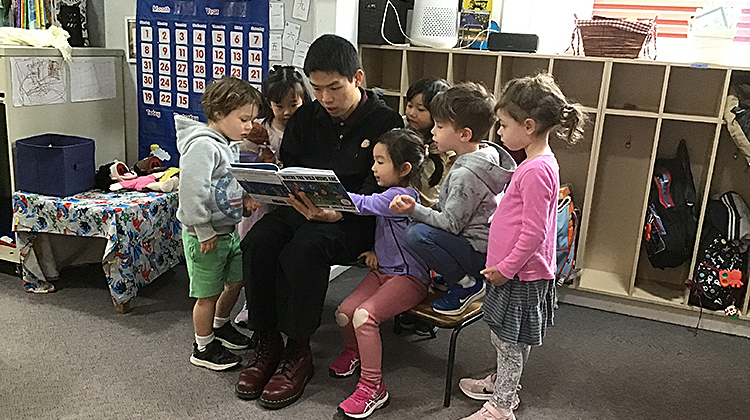The Forgotten Power Behind Reading Storybooks Aloud: Is It Still Relevant?

I vividly remember the moment during my study to become a teacher when a lecturer emphasised the power that reading storybooks has on children’s creativity, literacy, relationships, and overall learning development.
Research and academic studies show unanimous and overwhelming evidence of this being true (Phillips, 2000.; Anderson et al., 2003; Shickedanz & Collins, 2012; Suggate et al., 2013; Isik, 2016). It astonishes me how something so simple can be so powerful and it makes me excited to run off and start reading aloud to children straight away. Social scientists now consider read-aloud time one of the most vital indicators of providing the best start to children’s life (Gurdon, 2019).
However, as I delve into my teaching career over the years, working at numerous different services, I have seen that this traditional teaching method of storybook reading aloud is often taken lightly and been thought of being too ‘simple’ for teachers to utilise.
I happened to stumble upon Meghan Cox Gurdon’s ‘The Enchanted Hour’ that convinced me once again of the hidden and pervasive power that storybook reading aloud has for children and educators and adults (Gurdon, 2019).
‘Is the saying ‘Less is more’ applicable here?
‘Perhaps this thought pattern stems from one of the unspoken insecurities teachers often have of feeling that they don’t do enough for the children, and they need to think of something more creative, entertaining with a more novel punch?
‘Perhaps storybook reading aloud has slowly lost its place in this fast-paced digital age of distraction? Because reading aloud also means sacrificing time for something else in the children’s daily routine?’ (Gurdon, 2019).
Brain and Behavioural Science
Listening to stories while looking at pictures stimulates children’s deep brain networks, fostering optimal cognitive development. Children who have lots of stories read to them are more likely to turn into children who enjoy strong relationships, have sharper focus, and greater emotional resilience and self-mastery (Shickedanz & Collins, 2012; Gurdon, 2019).
Children who are often read to and have access to a range of books show higher levels of receptiveness and agility in understanding literacy and language provocations (Phillips, 2000). They also show higher creativity and imaginative capabilities as they can visualise images in their minds (Gurdon, 2019). This matters as children’s brains from birth to 8 years old have a high level of plasticity and can grow and develop. Brain nerves that are active together will be wired together better (Gurdon, 2019).
The companionable aspect to the experience of shared reading cultivates empathy. Reading aloud is a gateway to diverse range of vocabulary development and a pathway to early reading skills (Suggate et al., 2013). Utilising stories as a teaching tool also fosters children’s sentence structure, consolidates new phrases, vocabulary, rhythm, punctuation, familiarity with new contexts and many other basic language functions (Isik, 2016).
The benefit extends to adults as we often have our attention pulled in endless directions and finding the time to read aloud or to be read to aloud is an effective restorative exercise, allowing us to slow down.
Storybook Read Aloud VS Watching Story Videos
Today’s technology and internet noise has given us much but has taken away much as well. Although watching story videos and reading storybooks aloud together have some similar features, the premises and effect is just not the same and the research of brain activation during these activities conveys this (Gurdon, 2019).
Watching story videos and engaging in screen time pulls individuals into their own little bubbles, but storybooks or shared reading draws people together in an imaginative and reciprocal bubble of joy, encouraging them to ask questions, and fostering engagement (Suggate et al., 2013).
Story videos can also lead to overstimulation that leads to feeling mentally scattered, but storybooks read aloud helps the brain to engage in deep and sustained attention (Gurdon, 2019).
The brain activations in children who engage in story read-aloud show neurons firing and connecting together, indicating higher-order brain network development, compared to children who watch a story video which shows minimal neuron activation, except for neurons associated with visual perception (Gurdon, 2019).
Though story read-aloud presents itself as an excellent teaching tool, educators and teachers still need to be strategic in using the technique to provide meaningful learning. Educators are encouraged to plan and reflect on their learning intentions, execution on the storytelling and provide possible learning extensions such as activities or staging of the learning environment (Phillips, 2000; Anderson et al., 2003).
What about other variations of free story telling (no books) or silent reading by children (reading independently)? Both provide a rich number of benefits to individuals of all ages, and engaging with both in a variety of ways is encouraged for a meaningful learning experience (Suggate et al., 2013).
Reading stories aloud makes one think about other traditional teaching methods that we need to refresh our understanding on.
'We let down our guard when someone we love is reading us a story. We exist together in a little patch of warmth and light.' Kate DiCamillo
References
Anderson, J., Anderson, A., Lynch, J., & Shapiro, J. (2003). On reading books to children: Parents and teachers. Chapter 3: Storybook sharing as cultural practice. University of British Columbia
Gurdon, M.C. (2019). The Enchanted Hour: The Miraculous Power of Reading Aloud in the Age of Distraction. Piatkus Publishing.
Isik, M.A. (2016). The impact of storytelling on young ages. European Journal of Language and Literature Studies, 2(3), 115-118.
Phillips, L. (2000). Storytelling – the seeds of children’s creativity. Australasian Journal of Early Childhood. DOI: 10.1177/183693910002500302
Shickedanz, J. & Collins, M.F. (2012). For young children, pictures in storybooks are rarely worth a thousand words. The Reading Teacher, 65(8), 539-549. DOI: 10.1002/TRTR.01080
Suggate, S.P., Lenhard, W., Neudecker, E., Schneider, W. (2013). Incidental vocabulary acquisition from stories: Second and fourth graders learn more from listening than reading. First Language, 33(6), 551-571. DOI: 10.1177/0142723713503144